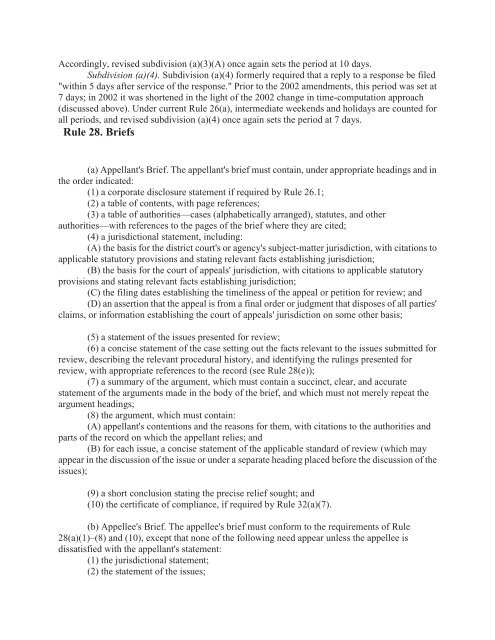Federal Rules of Appellate Procedure 2014-2015, 2014a
Federal Rules of Appellate Procedure 2014-2015, 2014a
Federal Rules of Appellate Procedure 2014-2015, 2014a
You also want an ePaper? Increase the reach of your titles
YUMPU automatically turns print PDFs into web optimized ePapers that Google loves.
Accordingly, revised subdivision (a)(3)(A) once again sets the period at 10 days.<br />
Subdivision (a)(4). Subdivision (a)(4) formerly required that a reply to a response be filed<br />
"within 5 days after service <strong>of</strong> the response." Prior to the 2002 amendments, this period was set at<br />
7 days; in 2002 it was shortened in the light <strong>of</strong> the 2002 change in time-computation approach<br />
(discussed above). Under current Rule 26(a), intermediate weekends and holidays are counted for<br />
all periods, and revised subdivision (a)(4) once again sets the period at 7 days.<br />
Rule 28. Briefs<br />
(a) Appellant's Brief. The appellant's brief must contain, under appropriate headings and in<br />
the order indicated:<br />
(1) a corporate disclosure statement if required by Rule 26.1;<br />
(2) a table <strong>of</strong> contents, with page references;<br />
(3) a table <strong>of</strong> authorities—cases (alphabetically arranged), statutes, and other<br />
authorities—with references to the pages <strong>of</strong> the brief where they are cited;<br />
(4) a jurisdictional statement, including:<br />
(A) the basis for the district court's or agency's subject-matter jurisdiction, with citations to<br />
applicable statutory provisions and stating relevant facts establishing jurisdiction;<br />
(B) the basis for the court <strong>of</strong> appeals' jurisdiction, with citations to applicable statutory<br />
provisions and stating relevant facts establishing jurisdiction;<br />
(C) the filing dates establishing the timeliness <strong>of</strong> the appeal or petition for review; and<br />
(D) an assertion that the appeal is from a final order or judgment that disposes <strong>of</strong> all parties'<br />
claims, or information establishing the court <strong>of</strong> appeals' jurisdiction on some other basis;<br />
(5) a statement <strong>of</strong> the issues presented for review;<br />
(6) a concise statement <strong>of</strong> the case setting out the facts relevant to the issues submitted for<br />
review, describing the relevant procedural history, and identifying the rulings presented for<br />
review, with appropriate references to the record (see Rule 28(e));<br />
(7) a summary <strong>of</strong> the argument, which must contain a succinct, clear, and accurate<br />
statement <strong>of</strong> the arguments made in the body <strong>of</strong> the brief, and which must not merely repeat the<br />
argument headings;<br />
(8) the argument, which must contain:<br />
(A) appellant's contentions and the reasons for them, with citations to the authorities and<br />
parts <strong>of</strong> the record on which the appellant relies; and<br />
(B) for each issue, a concise statement <strong>of</strong> the applicable standard <strong>of</strong> review (which may<br />
appear in the discussion <strong>of</strong> the issue or under a separate heading placed before the discussion <strong>of</strong> the<br />
issues);<br />
(9) a short conclusion stating the precise relief sought; and<br />
(10) the certificate <strong>of</strong> compliance, if required by Rule 32(a)(7).<br />
(b) Appellee's Brief. The appellee's brief must conform to the requirements <strong>of</strong> Rule<br />
28(a)(1)–(8) and (10), except that none <strong>of</strong> the following need appear unless the appellee is<br />
dissatisfied with the appellant's statement:<br />
(1) the jurisdictional statement;<br />
(2) the statement <strong>of</strong> the issues;


















